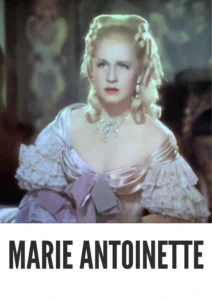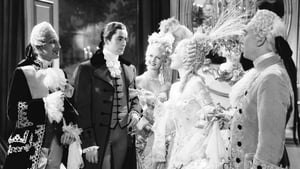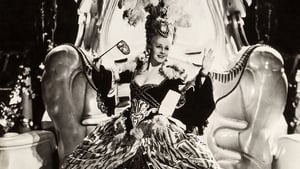Contact: info@alwanfilm.com
Video Sources 0 Views

Synopsis
Marie Antoinette 1938 Colorized Review: A Lavish Historical Drama in Color

Introduction
Few figures in history have been as divisive and iconic as Marie Antoinette, and the 1938 film Marie Antoinette, directed by W.S. Van Dyke, captures the dramatic rise and tragic fall of the ill-fated Queen of France with elegance and grandeur. Originally shot in black and white, this lavish period drama was eventually colorized, offering a visually stunning take on the French royal court and the turbulent era leading up to the French Revolution. In this review, we will explore how the colorized version of Marie Antoinette (1938) enhances the viewing experience, the importance of the film within the historical drama genre, and its place in film history.
Check The Full Colorized Movies List
Check Our Colorized Movies Trailer Channel
Understanding Marie Antoinette 1938 Colorized: Director, Cast, and Genre
Director’s Vision
W.S. Van Dyke, often referred to as “One Take Woody” due to his efficient directing style, helmed Marie Antoinette (1938) with an eye for detail and an emphasis on grandeur. Known for films like The Thin Man and San Francisco, Van Dyke was adept at handling both drama and spectacle. With Marie Antoinette, his goal was to portray the queen not only as a historical figure but as a deeply human character trapped by the whims of fate and power.
His direction takes the audience from the lavish excesses of Versailles to the grim realities of revolution, carefully balancing historical accuracy with the demands of a dramatic narrative. Van Dyke’s meticulous approach to set design and costuming added to the film’s immersive experience, and his focus on the personal struggles of Marie Antoinette gave the film a compelling emotional depth.
The Iconic Performance of Actors
Marie Antoinette (1938) boasts a stellar cast, headlined by Norma Shearer, whose portrayal of the doomed queen is nothing short of iconic. Shearer’s performance is both sympathetic and regal, capturing the complexity of Marie Antoinette as she transforms from a carefree, indulgent girl into a woman facing the harsh realities of revolution and imprisonment.
Tyrone Power plays the Swedish Count Axel von Fersen, Marie Antoinette’s rumored lover, and delivers a charismatic and emotional performance that complements Shearer’s nuanced portrayal. His chemistry with Shearer adds layers to the film, particularly in the moments of tenderness and loyalty that emerge amid the chaos of the French Revolution.
John Barrymore, as King Louis XV, adds gravitas to the film, portraying the decadence of the old French monarchy with flair. The film’s ensemble cast, which also includes Robert Morley as King Louis XVI and Joseph Schildkraut as the scheming Duke of Orleans, provides a rich array of characters that contribute to the courtly intrigue and political machinations that define the film.
Exploring the Genre
As a historical drama, Marie Antoinette (1938) stands out for its attention to detail and its commitment to accurately portraying the opulence of 18th-century France. The film is not just a biographical account of the queen’s life, but a sweeping narrative of political upheaval, personal tragedy, and the inevitable clash between monarchy and revolution. It belongs to the classic Hollywood period piece genre, where history is often heightened by dramatic storytelling and larger-than-life characters.
The genre thrives on spectacle, and Marie Antoinette delivers with its grand ballrooms, extravagant costumes, and intricate set designs that recreate the luxury of Versailles. At the same time, the film doesn’t shy away from the darker aspects of Marie Antoinette’s life—her isolation, her failures, and ultimately, her downfall. This balance of glamour and tragedy makes Marie Antoinette a prime example of the historical drama genre done right.
Exploring the World of Marie Antoinette 1938 Colorized: Plot and Characters
Detailed Synopsis
Marie Antoinette (1938) tells the life story of the Austrian princess who became the Queen of France. The film begins with the young Marie (played by Norma Shearer) being married off to Louis XVI (Robert Morley) as part of a political alliance between Austria and France. Initially depicted as naïve and fun-loving, Marie quickly learns that life at the French court is filled with intrigue, manipulation, and danger.
Her marriage to Louis XVI is strained, as the king is portrayed as awkward and indifferent to his queen. Isolated and lonely, Marie seeks comfort in the lavish lifestyle of Versailles, engaging in extravagant parties and spending, which earns her the disdain of the French people. Her rumored love affair with Count Axel von Fersen (Tyrone Power) offers her an emotional reprieve, but it only adds to the scandals surrounding her.
As the French Revolution brews, Marie Antoinette finds herself and her family at the center of the growing unrest. The film follows her through the storming of the Bastille, the fall of the monarchy, and her imprisonment, leading up to her eventual execution by guillotine. The film presents Marie not only as a symbol of the excesses of the monarchy but as a tragic figure, caught in circumstances beyond her control.
The Complex Protagonist and Memorable Supporting Characters
Norma Shearer’s portrayal of Marie Antoinette gives the queen a depth that transcends the simplistic caricature of “Madame Deficit.” Her transformation from a carefree girl to a regal and defiant woman facing her tragic end is a powerful character arc. Shearer captures the queen’s vulnerability, her occasional recklessness, and ultimately, her strength in the face of adversity.
Robert Morley’s portrayal of Louis XVI is both sympathetic and frustrating. His Louis is portrayed as indecisive and weak, ill-equipped to deal with the escalating crisis. Yet, Morley imbues the king with a sense of humanity, making his tragic fate feel inevitable rather than villainous.
The supporting characters, including the charming but ill-fated Count Axel von Fersen (Tyrone Power) and the scheming Duke of Orleans (Joseph Schildkraut), add layers of intrigue and drama to the film, making it a well-rounded ensemble piece that focuses on both the personal and political aspects of Marie Antoinette’s life.
The Art of Film Colorization
Understanding the Process
Film colorization involves adding color to black-and-white footage, either manually or digitally, and it has been a controversial topic since its inception. For a film like Marie Antoinette (1938), which is known for its grand visuals, colorization offers a chance to see the elaborate sets, costumes, and details in vivid hues.
The process requires careful attention to historical accuracy, particularly in a period film like this, where the colors of costumes and settings play a crucial role in evoking the time period. Modern digital colorization techniques use sophisticated software to enhance the original black-and-white footage, ensuring that the colors appear natural and true to the era depicted.
Development Over Time
The early attempts at colorizing films were rudimentary, often resulting in flat, unrealistic colors. However, as technology has advanced, the quality of colorized films has improved significantly. The colorization of Marie Antoinette offers a chance to appreciate the film’s visual grandeur in a way that the original black-and-white version could not fully convey.
Early Colored Films: A Brief History
Emergence of Early Colored Techniques
Color in cinema has a long and fascinating history. In the early 20th century, filmmakers began experimenting with tinting and toning techniques to add color to specific scenes. Later, the development of Technicolor in the 1930s revolutionized the industry by allowing films to be shot entirely in color.
By the time Marie Antoinette was released in 1938, color films were still relatively rare, and black-and-white remained the standard for most productions. The colorization of Marie Antoinette in later years gave it a new lease on life, offering audiences a fresh way to experience its visual splendor.
Marie Antoinette 1938 and Its Early Colored Version
The Decision to Release in Color
The decision to release a colorized version of Marie Antoinette (1938) was driven by a desire to reintroduce the film to modern audiences who might be more accustomed to color films. The opulence of the French court, with its glittering chandeliers, elaborate ball gowns, and majestic palaces, is enhanced by the use of color, making the film feel more immersive and visually captivating.
Impact on the Visual Narrative
The addition of color to Marie Antoinette brings a new dimension to the film’s visual narrative. The colorization highlights the contrast between the decadent lifestyle of the French aristocracy and the grim reality of the revolution, underscoring the film’s themes of excess and downfall. However, some purists may argue that the colorized version detracts from the film’s original aesthetic, which was designed with the limitations of black-and-white cinematography in mind.
The Debate Over Film Colorization
Controversy Surrounding Colorization
Film colorization has long been a topic of controversy among filmmakers and cinephiles. Critics argue that colorizing black-and-white films alters the director’s original vision and can distort the intended mood and atmosphere of a film. In the case of Marie Antoinette, the lush black-and-white cinematography was carefully crafted to evoke a certain tone, and some believe that adding color undermines that artistry.
On the other hand, proponents of colorization argue that it can breathe new life into classic films, making them more appealing to modern audiences. By offering a new way to experience the film, colorization can attract viewers who might otherwise be put off by black-and-white movies.
Examining Marie Antoinette 1938 as an Early Colored Film
Enhancement or Distraction?
The colorization of Marie Antoinette (1938) undeniably adds visual appeal, particularly in a film so rooted in the opulence of its setting. The vibrant costumes and lavish interiors benefit from the use of color, making the French royal court come alive in a way that black-and-white footage could not fully achieve. However, there is a delicate balance between enhancing the viewing experience and distracting from the film’s original artistry.
For some viewers, the colorized version may feel more accessible and visually engaging, while others may prefer the stark contrasts and dramatic shadows of the original black-and-white cinematography. Ultimately, whether colorization enhances or detracts from the film depends on personal preference and one’s perspective on preserving cinematic history.
Influence and Legacy: Marie Antoinette 1938 Colorized’s Impact on Cinema
Influence on Historical Dramas
Marie Antoinette (1938) set a standard for historical dramas with its meticulous attention to detail, grand production values, and focus on character-driven storytelling. The film’s influence can be seen in later period dramas, which often strive for the same balance of spectacle and intimacy.
The film’s success also helped solidify the genre’s appeal in Hollywood, paving the way for future historical epics that would tackle similarly ambitious subjects. Films like Gone with the Wind (1939) and Cleopatra (1963) owe a debt to Marie Antoinette for its bold approach to historical filmmaking.
The Legacy of Norma Shearer’s Performance
Norma Shearer’s portrayal of Marie Antoinette remains one of her most celebrated performances, and it helped cement her status as one of Hollywood’s leading ladies. Her ability to convey both the youthful exuberance and the tragic dignity of the queen made her performance a touchstone for future portrayals of historical figures in cinema.
Director’s Cinematic Legacy: Beyond Marie Antoinette 1938 Colorized
W.S. Van Dyke’s contributions to cinema extend far beyond Marie Antoinette. His body of work, which spans various genres, showcases his versatility and talent for storytelling. While Marie Antoinette stands out as one of his most ambitious projects, his other films, such as The Thin Man series and San Francisco, demonstrate his ability to craft engaging narratives across different cinematic styles.
Van Dyke’s influence on Hollywood is seen in his efficient directing methods and his ability to balance spectacle with intimate character moments. His work on Marie Antoinette in particular set a high bar for historical dramas, influencing directors who sought to blend history with drama in a similarly grand fashion.
Themes Explored in Marie Antoinette 1938 Colorized
Darkness, Violence, and Morality
Marie Antoinette (1938) explores themes of excess, downfall, and the consequences of political and personal choices. The film doesn’t shy away from the darker aspects of Marie Antoinette’s life, including her growing isolation, her eventual imprisonment, and the violence of the revolution. These themes are woven throughout the narrative, making the film both a personal tragedy and a reflection on the perils of absolute power.
Gender, Power, and Society
The film also delves into issues of gender and power, particularly through its portrayal of Marie Antoinette’s struggles in a male-dominated political world. As queen, she is both revered and reviled, with much of the public’s anger directed at her despite the failings of her husband and the monarchy as a whole. Her journey from a naive young princess to a defiant woman facing execution mirrors the shifting tides of power in French society.
Reception and Controversy Surrounding Marie Antoinette 1938 Colorized
Initial Reviews and Audience Reactions
Upon its release, Marie Antoinette (1938) was praised for its grandeur, its performances, and its historical accuracy. Norma Shearer’s portrayal of the queen was particularly lauded, earning her an Academy Award nomination for Best Actress. The film’s sweeping visuals and dramatic storytelling made it a hit with audiences, cementing its place as a classic of the historical drama genre.
However, as with many historical films, Marie Antoinette faced some criticism for taking liberties with the facts in order to create a more engaging narrative. The colorization of the film in later years sparked further debate, with some arguing that it detracted from the original black-and-white aesthetic.
Where to Watch Marie Antoinette 1938 Colorized Online
For viewers interested in experiencing the grandeur of Marie Antoinette (1938), the film is available on various streaming platforms, including Amazon Prime Video and Turner Classic Movies. DVD and Blu-ray editions, including colorized versions, are also available for purchase, offering both the original black-and-white and colorized formats.
FAQs About Marie Antoinette 1938 Colorized
Q: Was Marie Antoinette (1938) originally shot in color?
A: No, the film was originally shot in black and white. The colorized version was created later using digital colorization techniques.
Q: How historically accurate is Marie Antoinette (1938)?
A: While the film takes some liberties with historical events for dramatic purposes, it is generally considered to be a fairly accurate portrayal of the life of Marie Antoinette and the French Revolution.
Q: What awards did Marie Antoinette (1938) receive?
A: The film received several Academy Award nominations, including Best Actress for Norma Shearer, Best Supporting Actor for Robert Morley, and Best Art Direction.
Q: Who played Marie Antoinette in the 1938 film?
A: Norma Shearer portrayed Marie Antoinette in the 1938 film, delivering one of her most iconic performances.
Conclusion
Marie Antoinette (1938) remains a classic of historical cinema, combining opulence, tragedy, and powerful performances to tell the story of one of history’s most infamous queens. The colorized version adds a new layer of visual richness to the film, enhancing the grandeur of the French court while sparking debate about the merits of colorization. Whether viewed in its original black-and-white or in color, Marie Antoinette (1938) stands as a testament to the enduring power of historical drama and the complex legacy of its tragic heroine.












